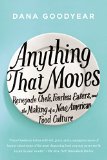Summary | Excerpt | Reviews | Beyond the Book | Readalikes | Genres & Themes | Author Bio
Renegade Chefs, Fearless Eaters, and the Making of a New American Food Culture

Critics' Opinion:
Readers' Opinion:
First Published:
Nov 2013, 272 pages
Paperback:
Nov 2014, 272 pages
 Book Reviewed by:
Book Reviewed by:
Poornima Apte
Buy This Book
The Hump was singularly well located, overlooking the runway at the Santa Monica
Airport, a great place to watch rattling vintage planes and featherweight experimental
aircraft take off and land. It served things few others could or would: blowfish, which
contains a deadly toxin and can be fatal if improperly prepared; keiji, super-fatty
salmon babies which, before they are sexually mature, follow the adult fish to the rivers,
where they are harvested. (One in ten thousand salmon caught is keiji, and the
price can be as high as $150 a pound.) A sign on the door read, "Warning! This sushi bar
does prepare live sea food in full view, at the counter." It was routine to see a chef
take out a live eel and drive a spike through its brain, and serve it seconds later. Live
lobster would be cut in half and presented with the tail meat draped over the carapace,
and the head, still moving, beside it on a bed of ice. Eddie Lin, who writes an adventure-
eating blog called Deep End Dining and frequented The Hump, said, "The effect of it is the
animal is watching you eat it."
Brian Vidor, the restaurant's owner, is tall, with bushy white hair and the warm but
slightly furtive manner of someone who has spent too much time in camp. In the seventies,
he worked as a guide in the safari park at Great Adventure in New Jersey. Then
Chipperfield's, a British circus-and-carnival company, hired him to go the Sudan to
capture white rhino calves, elephants, hartebeests, and topi for a zoo in Prague. They
scouted for the animals from the air, in a small plane called a Piper Super Cub, and
rounded them up with trucks, darting the mothers with tranquilizers so they would not
stampede when the hunters took their young.
After that, Vidor took a job with a company called International Animal Exchange
building a safari park—baboons, giraffes, rhinos, elephants, tigers—in Miyazaki, Japan.
For the next fifteen or so years, he travelled all over Asia, building zoos. In Taipei, he
drank snake blood in Snake Alley, and tried his first insect: a Jerusalem cricket, fried
with garlic and red pepper, served with beer. In Singapore, he had scorpions on toast. By
the early nineties, he had become a flight instructor. Landing at the Santa Monica
Airport, he noticed a "for lease" sign, and decided to become a restaurateur,
recreating his favorite Asian street foods at a restaurant called Typhoon, where part of the menu
was devoted to edible insects. Following Jonathan Gold's recommendations, Vidor often
ate in the San Gabriel Valley. Several years later, he opened The Hump upstairs for the
customers who had graduated to a more morally complex and expensive confrontation with
omnivorousness.
Whale consumption occupies a special place in the Japanese conscience. In "Tsukiji," a
book about the Tokyo fish market, Theodore Bestor, a professor of anthropology and
Japanese studies at Harvard, writes that whales are the object of "ritual concern,"
mourned in special Buddhist services called kuyo. Historically and etymologically
considered fish—kujira, the word in Japanese, means "major fish"—whales were exempt
from Buddhist prohibitions against eating meat. (Catholics, historically, saw the issue
similarly, and allowed whale on Fridays.) After the war, when there were food shortages,
it became an important source of protein. Canned whale, mostly less desirable sperm whale,
became the Spam of mid-century Japan, remembered fondly by some aging Japanese, reviled by
others as something they ate only in desperation.
In spite of the moratorium, Japan continues to take several hundred whales a year in
the name of scientific research. Before it was possible to collect accurate D.N.A. from
small tissue samples, they said they needed genetic information to understand stock
structure; now they say that they need to examine the stomach contents for the purposes of
ecosystem management. The hunt, which is accomplished by firing an exploding harpoon at
the whale, is considered by many to be inherently inhumane. In any case, U.S. scientists have a hard time finding anything useful in the Japanese data, because the whalers go only where they know the whales to be, and do not carry scientific observers
aboard. Pro-whaling politicians and organizations insist that whale stocks are healthy,
and characterize the opposition as "culinary imperialism."
Excerpted from Anything That Moves by Dana Goodyear. Copyright © 2013 by Dana Goodyear. Excerpted by permission of Riverhead Books. All rights reserved. No part of this excerpt may be reproduced or reprinted without permission in writing from the publisher.





The Flower Sisters
by Michelle Collins Anderson
From the new Fannie Flagg of the Ozarks, a richly-woven story of family, forgiveness, and reinvention.

The House on Biscayne Bay
by Chanel Cleeton
As death stalks a gothic mansion in Miami, the lives of two women intertwine as the past and present collide.

The Funeral Cryer by Wenyan Lu
Debut novelist Wenyan Lu brings us this witty yet profound story about one woman's midlife reawakening in contemporary rural China.
Your guide toexceptional books
BookBrowse seeks out and recommends the best in contemporary fiction and nonfiction—books that not only engage and entertain but also deepen our understanding of ourselves and the world around us.